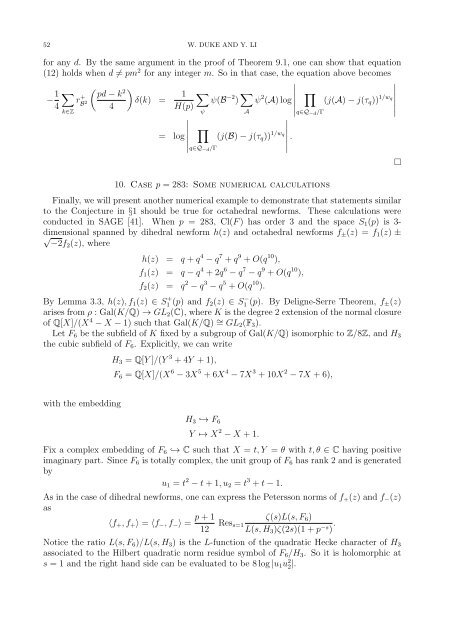Mock-modular forms of weight one - UCLA Department of Mathematics
Mock-modular forms of weight one - UCLA Department of Mathematics
Mock-modular forms of weight one - UCLA Department of Mathematics
Create successful ePaper yourself
Turn your PDF publications into a flip-book with our unique Google optimized e-Paper software.
52 W. DUKE AND Y. LI<br />
for any d. By the same argument in the pro<strong>of</strong> <strong>of</strong> Theorem 9.1, <strong>one</strong> can show that equation<br />
(12) holds when d ≠ pm 2 for any integer m. So in that case, the equation above becomes<br />
∣<br />
− 1 ∑<br />
( ) pd − k<br />
r + 2<br />
1 ∑<br />
B<br />
δ(k) = ψ(B −2 ) ∑ ∣∣∣∣∣<br />
∏<br />
ψ 2 (A) log<br />
4<br />
2 4<br />
H(p)<br />
− j(τ q ))<br />
k∈Z<br />
ψ<br />
A ∣q∈Q −d /Γ(j(A) 1/wq ∣ ∣∣∣∣∣ ∏<br />
= log<br />
(j(B) − j(τ q )) 1/wq .<br />
∣<br />
q∈Q −d /Γ<br />
10. Case p = 283: Some numerical calculations<br />
Finally, we will present another numerical example to demonstrate that statements similar<br />
to the Conjecture in §1 should be true for octahedral new<strong>forms</strong>. These calculations were<br />
conducted in SAGE [41]. When p = 283, Cl(F ) has order 3 and the space S 1 (p) is 3-<br />
dimensional spanned by dihedral newform h(z) and octahedral new<strong>forms</strong> f ± (z) = f 1 (z) ±<br />
√ −2f2 (z), where<br />
h(z) = q + q 4 − q 7 + q 9 + O(q 10 ),<br />
f 1 (z) = q − q 4 + 2q 6 − q 7 − q 9 + O(q 10 ),<br />
f 2 (z) = q 2 − q 3 − q 5 + O(q 10 ).<br />
By Lemma 3.3, h(z), f 1 (z) ∈ S + 1 (p) and f 2 (z) ∈ S − 1 (p). By Deligne-Serre Theorem, f ± (z)<br />
arises from ρ : Gal(K/Q) → GL 2 (C), where K is the degree 2 extension <strong>of</strong> the normal closure<br />
<strong>of</strong> Q[X]/(X 4 − X − 1) such that Gal(K/Q) ∼ = GL 2 (F 3 ).<br />
Let F 6 be the subfield <strong>of</strong> K fixed by a subgroup <strong>of</strong> Gal(K/Q) isomorphic to Z/8Z, and H 3<br />
the cubic subfield <strong>of</strong> F 6 . Explicitly, we can write<br />
H 3 = Q[Y ]/(Y 3 + 4Y + 1),<br />
F 6 = Q[X]/(X 6 − 3X 5 + 6X 4 − 7X 3 + 10X 2 − 7X + 6),<br />
□<br />
with the embedding<br />
H 3 ↩→ F 6<br />
Y ↦→ X 2 − X + 1.<br />
Fix a complex embedding <strong>of</strong> F 6 ↩→ C such that X = t, Y = θ with t, θ ∈ C having positive<br />
imaginary part. Since F 6 is totally complex, the unit group <strong>of</strong> F 6 has rank 2 and is generated<br />
by<br />
u 1 = t 2 − t + 1, u 2 = t 3 + t − 1.<br />
As in the case <strong>of</strong> dihedral new<strong>forms</strong>, <strong>one</strong> can express the Petersson norms <strong>of</strong> f + (z) and f − (z)<br />
as<br />
〈f + , f + 〉 = 〈f − , f − 〉 = p + 1<br />
12<br />
Res s=1<br />
ζ(s)L(s, F 6 )<br />
L(s, H 3 )ζ(2s)(1 + p −s ) .<br />
Notice the ratio L(s, F 6 )/L(s, H 3 ) is the L-function <strong>of</strong> the quadratic Hecke character <strong>of</strong> H 3<br />
associated to the Hilbert quadratic norm residue symbol <strong>of</strong> F 6 /H 3 . So it is holomorphic at<br />
s = 1 and the right hand side can be evaluated to be 8 log |u 1 u 2 2|.
















